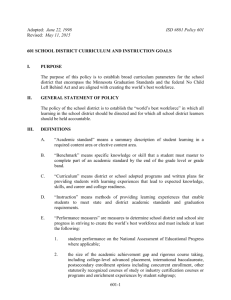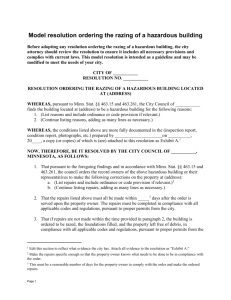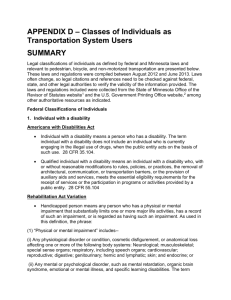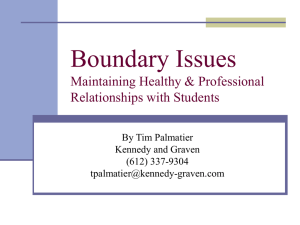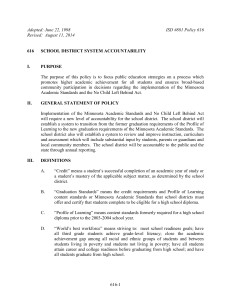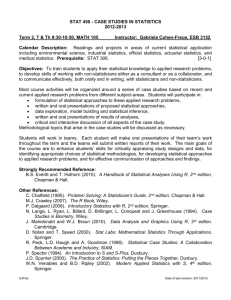805 waste reduction and recycling
advertisement
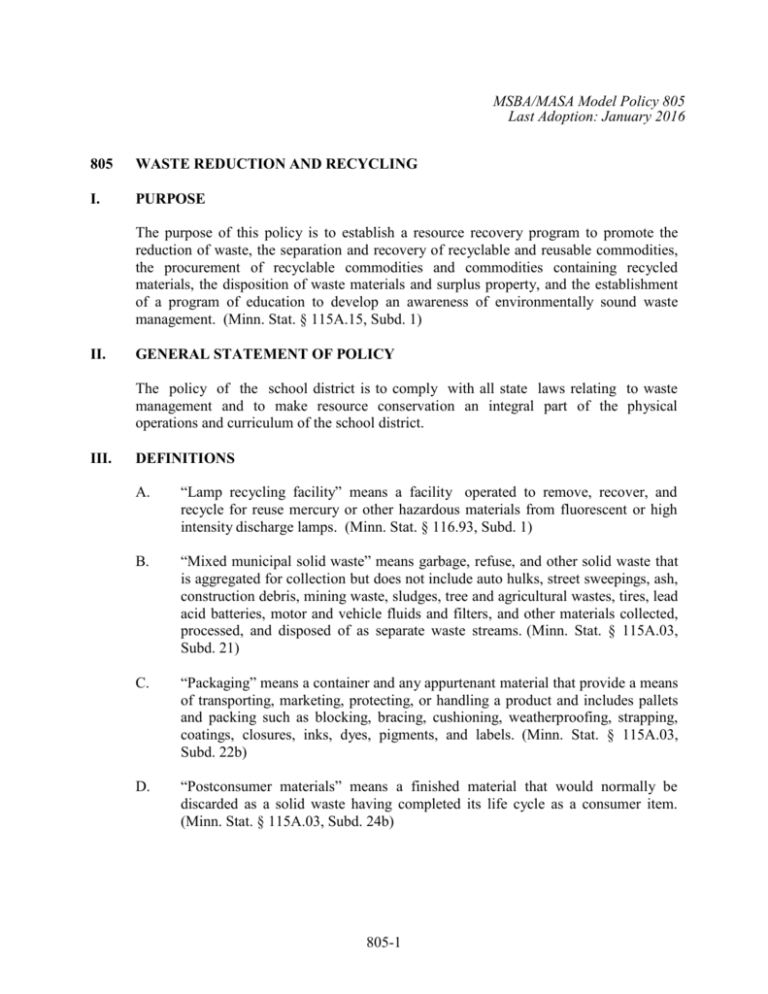
MSBA/MASA Model Policy 805 Last Adoption: January 2016 805 WASTE REDUCTION AND RECYCLING I. PURPOSE The purpose of this policy is to establish a resource recovery program to promote the reduction of waste, the separation and recovery of recyclable and reusable commodities, the procurement of recyclable commodities and commodities containing recycled materials, the disposition of waste materials and surplus property, and the establishment of a program of education to develop an awareness of environmentally sound waste management. (Minn. Stat. § 115A.15, Subd. 1) II. GENERAL STATEMENT OF POLICY The policy of the school district is to comply with all state laws relating to waste management and to make resource conservation an integral part of the physical operations and curriculum of the school district. III. DEFINITIONS A. “Lamp recycling facility” means a facility operated to remove, recover, and recycle for reuse mercury or other hazardous materials from fluorescent or high intensity discharge lamps. (Minn. Stat. § 116.93, Subd. 1) B. “Mixed municipal solid waste” means garbage, refuse, and other solid waste that is aggregated for collection but does not include auto hulks, street sweepings, ash, construction debris, mining waste, sludges, tree and agricultural wastes, tires, lead acid batteries, motor and vehicle fluids and filters, and other materials collected, processed, and disposed of as separate waste streams. (Minn. Stat. § 115A.03, Subd. 21) C. “Packaging” means a container and any appurtenant material that provide a means of transporting, marketing, protecting, or handling a product and includes pallets and packing such as blocking, bracing, cushioning, weatherproofing, strapping, coatings, closures, inks, dyes, pigments, and labels. (Minn. Stat. § 115A.03, Subd. 22b) D. “Postconsumer materials” means a finished material that would normally be discarded as a solid waste having completed its life cycle as a consumer item. (Minn. Stat. § 115A.03, Subd. 24b) 805-1 E. “Rechargeable battery” means a sealed nickel-cadmium battery, a sealed lead acid battery, or any other rechargeable battery, except certain dry cell batteries or a battery exempted by the Commissioner of the Pollution Control Agency (PCA) (Commissioner). (Minn. Stat. § 115A.9157) F. “Recyclable commodities” means materials, pieces of equipment, and parts which are not reusable but which contain recoverable resources. (Minn. Stat. § 115A.15, Subd. 1a(a)) G. “Recyclable materials” means materials that are separated from mixed municipal solid waste for the purpose of recycling or composting, including paper, glass, plastics, metals, automobile oil, batteries, and source-separated compostable materials. Refuse-derived fuel or other material that is destroyed by incineration is not a recyclable material. (Minn. Stat. § 115A.03, Subd. 25a) H. “Recycling” means the process of collecting and preparing recyclable materials and reusing the materials in their original form that do not cause the destruction of recyclable materials in a manner that precludes further use. (Minn. Stat. § 115A.03, Subd. 25b) I. “Resource conservation” means the reduction in the use of water, energy, and raw materials. (Minn. Stat. § 115A.03, Subd. 26a) J. “Reusable commodities” means materials, pieces of equipment, parts, and used supplies which can be reused for their original purpose in their existing condition. (Minn. Stat. § 115A.15, Subd. 1a(b)) K. “Source-separated compostable materials” means materials that: 1. are separated at the source by waste generators for the purpose of preparing them for use as compost; 2. are collected separately from mixed municipal solid waste and are governed by state licensing provisions; 3. are comprised of food wastes, fish and animal waste, plant materials, diapers, sanitary products, and paper that is not recyclable because the Commissioner has determined that no other person is willing to accept the paper for recycling; 4. are delivered to a facility to undergo controlled microbial degradation to yield a humus-like product meeting the PCA’s class I or class II, or equivalent, compost standards and where process residues do not exceed 15 percent by weight of the total material delivered to the facility; and 5. may be delivered to a transfer station, mixed municipal solid waste processing facility, or recycling facility only for the purposes of composting or transfer to a composting facility, unless the Commissioner 805-2 determines that no other person is willing to accept the materials. (Minn. Stat. § 115A.03, Subd. 32a) L. “Waste reduction” or “source reduction” means an activity that prevents generation of waste or the inclusion of toxic materials in waste, including: 1. reusing the product in its original form; 2. increasing the life span of a product; 3. reducing material or the toxicity of material used in production or packaging; or 4. changing procurement, consumption, or waste generation habits to result in smaller quantities or lower toxicity of waste generated. (Minn. Stat. § 115A.03, Subd. 36b) IV. WASTE DISPOSAL A. The school district will attempt to decrease the amount of waste consumable materials by: 1. reduction of the consumption of consumable materials whenever practicable; 2. full utilization of materials prior to disposal; 3. minimization of the use of non-biodegradable products whenever practicable. B. Each school district facility will have containers for at least three of the following recyclable materials: paper, glass, plastic, and metal. (Minn. Stat. § 115A.151) C. The school district will transfer all recyclable materials collected to a recycler and, to the extent practicable, cooperate with, and participate in, recycling efforts being made by the city and/or county where the school district is located. (Minn. Stat. § 115A.151) D. Prior to entering into a contract for the management of mixed municipal solid waste, the school district will determine whether the disposal method provided for in the contract is equal to or better than the waste management practices currently employed in the county or district plan in the county where the school district is located and whether the contract is consistent with the solid waste plan. If the waste management method provided for in the contract is ranked lower than the waste management practices employed by the county or district, the school district will: 805-3 1. determine the potential liability to the school district and its taxpayers for managing waste in this manner; 2. develop and implement a plan for managing the potential liability; and 3. submit the information in (1) and (2) above to the PCA. If the contract is inconsistent with the county plan or if the school district’s waste management activities are inconsistent with the county plan, the school district should obtain the consent of the county prior to entering into a binding contract or developing or implementing inconsistent solid waste management activities. (Minn. Stat. § 115A.46, Subd. 5; Minn. Stat. § 115A.471; Minn. Stat. § 458D.07, Subd. 4) E. The school district may not knowingly place motor oil, brake fluid, power steering fluid, transmission fluid, motor oil filters, or motor vehicle antifreeze (other than small amounts of antifreeze contained in water used to flush the cooling system of a vehicle after the antifreeze has been drained and does not include de-icer that has been used on the exterior of a vehicle) in or on: 1. solid waste or solid waste management facilities other than a recycling facility or household hazardous waste collection facility; 2. the land unless approved by the PCA; or 3. the waters of the state, an individual sewage treatment system, or in a storm water or waste water collection or treatment system unless: a. permitted to do so by the operator of the system and the PCA; b. the school district generates an annual average of less than 50 gallons of waste motor vehicle antifreeze per month; and c. the school district keeps records of the amount of waste antifreeze generated, maintains these records on site and makes the records available for inspection for a minimum of three years following generation of the waste antifreeze. (Minn. Stat. § 115A.916) F. The school district may not place mercury or a thermostat, thermometer, electric switch, appliance, gauge, medical or scientific instrument, fluorescent or highintensity discharge lamp, electric relay, or other electrical device from which the mercury has not been removed for reuse or recycling: 1. in solid waste; or 805-4 2. in a wastewater disposal system. (Minn. Stat. § 115A.932, Subd. 1(a)) G. The school district may not knowingly place mercury or a thermostat, thermometer, electric switch, appliance, gauge, medical or scientific instrument, fluorescent or high-intensity discharge lamp, electric relay, or other electrical device from which the mercury has not been removed for reuse or recycling: 1. in a solid waste processing facility; or 2. in a solid waste disposal facility. (Minn. Stat. § 115A.932, Subd. 1(b)) H. The school district will recycle a fluorescent or high-intensity discharge lamp by delivery of the lamp to a lamp recycling facility or to a facility that collects and stores lamps for the purpose of delivering them to a lamp recycling facility, including, but not limited to, a household hazardous waste collection or recycling facility, retailer take-back and utility provider program sites, or other sites designated by an electric utility under Minn. Stat. § 216B.241, Subds. 2 and 4. (Minn. Stat. § 115A.932, Subd. 1(c)) I. The school district may not place a lead acid battery in mixed municipal solid waste or dispose of a lead acid battery. The school district also may not place in mixed municipal solid waste a dry cell battery containing mercuric oxide electrode, silver oxide electrode, nickel-cadmium, or sealed lead-acid that was purchased for use or used by the school district. The school district also may not place in mixed municipal solid waste a rechargeable battery, a rechargeable battery pack, a product with a non-removable rechargeable battery, or a product powered by rechargeable batteries or rechargeable battery pack, from which all batteries or battery packs have not been removed. (Minn. Stat. § 115A.915; Minn. Stat. § 115A.9155, Subd. 1; Minn. Stat. § 115A.9157, Subd. 2) J. The school district may not place yard waste: 1. in mixed municipal solid waste; 2. in a disposal facility; 3. in a resource recovery facility, except for the purposes of reuse, composting, or cocomposting; or 4. in a plastic bag unless exempt as specified in Minn. Stat. § 115A.931(c), (d), or (e). (Minn. Stat. § 115A.931) 805-5 K. The school district may not place a telephone directory: 1. in solid waste; 2. in a disposal facility; or 3. in a resource recovery facility, except a recycling facility. (Minn. Stat. § 115A.951, Subd. 2) L. The school district may not: 1. place major appliances in mixed municipal solid waste; or 2. dispose of major appliances in or on the land or in a solid waste processing or disposal facility. (Minn. Stat. § 115A.9561) V. M. The school district may not place in mixed municipal solid waste an electronic product containing a cathode-ray tube. (Minn. Stat. § 115A.9565) N. The school district, on its own or in cooperation with others, may implement a program to collect, process, or dispose of household batteries. The school district may provide financial incentives to any person, including public or private civic groups, to collect the batteries. (Minn. Stat. § 115A.961, Subd. 3) PROCUREMENT OF RECYCLED COMMODITIES AND MATERIALS A. When practicable and when the price of recycled materials does not exceed the price of nonrecycled materials by more than ten percent, the school district may purchase recycled materials. In order to maximize the quantity and quality of recycled materials purchased, the school district may also use other appropriate procedures to acquire recycled materials at the most economical cost to the school district. (Minn. Stat. § 16C.073.3(a)) B. When purchasing commodities and services, the school district will apply and promote waste management practices with special emphasis on the reduction of the quantity and toxicity of materials in waste. (Minn. Stat. § 16C.073, Subd. 3(b)) C. Whenever practicable, the school district will: 1. purchase uncoated office paper and printing paper unless the coated paper is made with at least 50 percent postconsumer material; 2. purchase recycled content paper with at least ten percent postconsumer material by weight; 805-6 3. purchase paper which has not been dyed with colors, excluding pastel colors; 4. purchase recycled content paper that is manufactured using little or no chlorine bleach or chlorine derivatives; 5. use no more than two colored inks, standard or processed, except in formats where they are necessary to convey meaning; 6. use reusable binding materials or staples and bind documents by methods that do not use glue; 7. use soy-based inks; 8. produce reports, publications, and periodicals that are readily recyclable; 9. purchase paper which has been made on a paper machine located in Minnesota; 10. print documents on both sides of the paper where commonly accepted publishing practices allow; and 11. purchase copier paper that contains at least ten percent postconsumer material by fiber content. (Minn. Stat. § 16C.073, Subd. 2) VI. D. After July 1, 1998, the school district may not use a specified product included on the prohibited products list published in the State Register. (Minn. Stat. § 115A.9651) E. In developing bid specifications, the school district will consider the extent to which a commodity or product is durable, reusable or recyclable, and marketable through applicable local or regional recycling programs and the extent to which the commodity or product contains postconsumer material. (Minn. Stat. § 16C.073, Subd. 3(b)) F. When a project involves the replacement of carpeting, the school district may require all persons who wish to bid on the project to designate a carpet recycling company in their bids. (Minn. Stat. § 16C.073, Subd. 3(b)) OTHER The policy of the school district to actively advocate, where appropriate, for resource conservation practices to be adopted at the local, regional and state levels. Legal References: Minn. Stat. § 16C.073 (Purchase and Use of Paper Stock; 805-7 Printing) Minn. Stat. § 115A.03 (Definitions) Minn. Stat. § 115A.15 (State Government Resource Recovery) Minn. Stat. § 115A.151 (State and Local Facilities) Minn. Stat. § 115A.46 (Requirements) Minn. Stat. § 115A.471 (Public Entities; Management of Solid Waste) Minn. Stat. § 115A.915 (Lead Acid Batteries; Land Disposal Prohibited) Minn. Stat. § 115A.9155 (Disposal of Certain Dry Cell Batteries) Minn. Stat. § 115A.9157 (Rechargeable Batteries and Products) Minn. Stat. § 115A.916 (Motor Vehicle Fluids and Filters; Prohibitions) Minn. Stat. § 115A.931 (Yard Waste Prohibition) Minn. Stat. § 115A.932 (Mercury Prohibition) Minn. Stat. § 115A.951 (Telephone Directories) Minn. Stat. § 115A.9561 (Major Appliances) Minn. Stat. § 115A.9565 (Cathode-Ray Tube Prohibition) Minn. Stat. § 115A.961, Subd. 3 (Household Batteries; Collection, Processing, and Disposal) Minn. Stat. § 115A.9651 (Listed Metals in Specified Products, Enforcement) Minn. Stat. § 116.93, Subd. 1 (Lamp Recycling Facilities) Minn. Stat. § 216B.241, Subds. 2 and 4 (Energy Conservation Improvement) Minn. Stat. § 458D.07 (Sewage Collection and Disposal) National Solid Waste Management Ass’n v. Williams, et al., 966 F.Supp. 844 (D. Minn. 1997) Cross References: Revision History: Original: 1996 Revised: 2011, 2012, 2016 805-8
